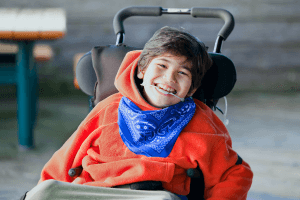Lifespan of Cerebral Palsy Sufferers Related to Symptom Severity
Call 410-825-5287 for a free medical malpractice consultation

Cerebral palsy (CP) affects thousands of new babies each and every year, leaving parents with concern regarding how long their child is expected to survive. Today, the majority of people living with CP can expect to live well into adulthood, often with a high quality of life. As a general rule, however, CP patients who experience the most severe motor, cognitive and/or sensory disabilities have the shortest lifespans. Additional factors have also been shown to influence length of survival in CP patients. Gratefully, proper management of the symptoms associated with CP can dramatically extend the time families have to share with their impaired loved one.
Profundity of Symptoms Impacts Lifespan of CP Patients
An important factor to consider in the relationship between CP and lifespan is the dramatic range of disabilities sufferers may experience. CP patients with only a few mild symptoms are the most likely to enjoy a long, unencumbered life. Those with a severe cognitive, motor or visual disability, however, have a much higher chance of succumbing to one or more complications of CP before they reach the age of 40. When CP related brain damage results in a combination of more than one type of severe disability, individuals typically have a 50 percent chance of reaching their teenage years. Fortunately, these profoundly impacted individuals represent a small percentage of total CP sufferers, with the majority having suffered less severe brain damage.
Severe Disabilities Exert Independent Yet Cumulative Influences on Lifespan
Each of the primary disabilities seen in CP cases exerts a unique and independent effect on lifespan. CP sufferers with one or more disabilities within the following categories have been monitored to determine the percentage of patients still alive at the age of 30:
- Cognitive challenges. When brain damage results in a severe learning disability, the affected individual will be left with a 62 percent chance of survival to 30.
- A severe motor disability. The inability to feed and dress oneself (manual disorder) or an ambulatory disorder which requires the individual to use a self-propelled wheelchair reduces the chance of survival to the third decade to 42 percent.
- Those with extreme visual challenges. Patients with 6/60 vision or poorer in their better eye tend to have shorter lifespans than those with a severe disability in the other categories. Sadly, such individuals have a mere 38 percent chance of surviving to their 30th birthday.
- Auditory challenges. Although they are classified as a sensory disability along with visual challenges, hearing difficulties are not correlated with a shortened lifespan, even in those who are entirely deaf.
As noted previously, individuals with more than one CP related severe disability have a much poorer prognosis than those with only one challenge; three quarters of such individuals will have passed on within their first 30 years of life.
Additional Factors Which Influence Lifespan
Beyond severity of symptoms, a number of additional factors have been shown to influence the overall lifespan of CP patients, including:
- Birth weight. In a surprising correlation, smaller babies seem to fare better than bigger babies; nearly 90 percent of infants weighing a mere 1000g at birth live beyond their 30th birthday. Studies show that the average length of survival declines as birth weight increases, with less than 80 percent of babies born at 5000g or more making it through those first three decades.
- The presence or absence of epilepsy. Like CP patients, those who suffer from epilepsy have a wide range of severity and frequency of symptoms. As a general rule, however, CP sufferers who also experience seizures live shorter lives than those who do not.
- The time period when CP related brain damage occurred. Well over three quarters of children who have suffered brain damage resulting in CP have experienced the causative trama before reaching the age of one month; this is known as early impairment cerebral palsy (EICP). Occasionally, an older baby may experience head trauma which ultimately results in late impairment cerebral palsy (LICP); such children tend to have more severe CP symptoms and shorter lifespans than those with EICP.
Gender. Female children with CP tend to live longer than boys; this is especially true for LICP cases, where 80 percent of girls will live to the age of 30 as opposed to 69 percent of impacted boys.
Death Typically Results From CP Complications
Because CP is a non-progressive disorder, any damage to the brain which underlies the disability of a CP affected individual will not progress as the person ages. As a result, it is typically one or more of the complications that frequently arise from CP symptoms which ultimately leads to a person's demise. Such complications may include:
- Challenges eating food. Muscle stiffness in the jaws may prevent CP sufferers from properly chewing and swallowing food, thus making them more prone to choking and the development of lung infections resulting from inhaled food particles. Malnutrition may occur if the level of food intake is not adequate.
- Pressure sores. Those who are confined to a wheelchair or bed may suffer from pressure sores which, if left untreated, can develop into a life threatening condition.
- Premature aging. Muscles, including the heart, tend to age more quickly when they are infrequently used; as a result, the restricted movement associated with CP tends to deteriorate muscles at a faster pace than in unaffected individuals.
Physical and emotional pain. CP patients tend to experience higher levels of depression and physical pain when compared to the general population. Although the exact reason for the correlation between pain and shortened lifespan is not known, such factors have been shown to increase the chances of an early demise.
Proper Care Essential for a Longer Life
Proper care which mitigates the most common complications associated with CP will allow many CP patients to live a long, healthy life. Severe feeding challenges can be overcome with gastrostomy surgery which allows food to be delivered directly into the stomach. Attentive caregivers can minimize risks associated with pressure sores and emotional pain; physical pain can be managed with a combination of physical therapy, diet and medication when required. Careful management of seizures is critical for CP patients who also suffer from epilepsy, and any additional medical condition (hypertension, osteoporosis, etc.) must be monitored and addressed with the help of a qualified medical care provider.
Hope for Those Who Suffer - Accountability for Those Responsible
Modern medical technologies provide a high degree of hope for those who suffer from CP, yet it is critical for parents to hold potentially negligent providers responsible for their actions in order to prevent harm from being done to others. Additionally, financial compensation is a critical factor for the families of CP impaired individuals who require life long care. If you believe your child's CP may have been the result of medical negligence, don't hesitate to contact a professional attorney today.
Accolades for Weltchek Mallahan & Weltchek
OVER $600 MILLION IN VERDICTS & SETTLEMENTS FOR OUR CLIENTS




